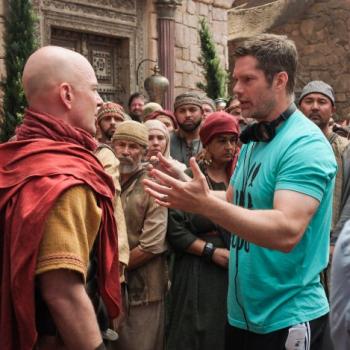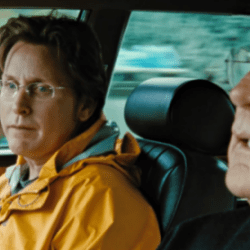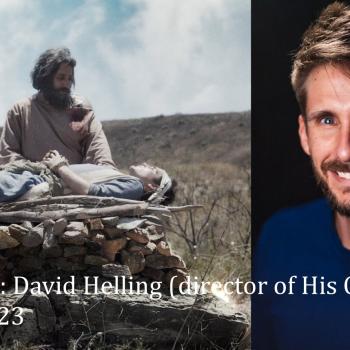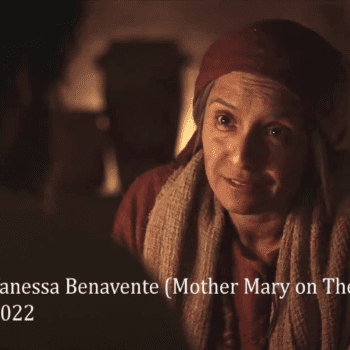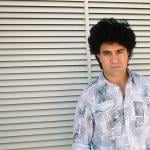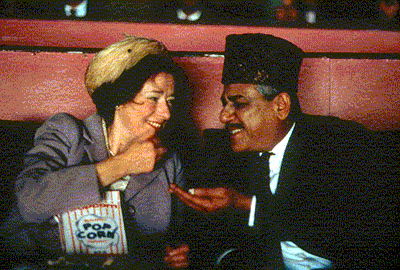
Variety reports that Om Puri has been appointed head of the National Film Development Council in India, and this, for no particular reason, gets me thinking back to when I interviewed Puri eight years ago, shortly before the North American release of East Is East (1999). Here is the article, originally published in the Vancouver Courier, that came out of that interview:
– – –
by Peter T. Chattaway
Om Puri has worked on dozens of films in his native India, but North American audiences may recognize him more for his supporting roles in such films as Wolf and The Ghost and the Darkness. Puri has also starred in prestigious period pics and noteworthy Canadian films like Such a Long Journey and Sam & Me, Deepa Mehta’s 1991 directorial debut.
But in recent years, he may have received his greatest international recognition from a pair of films about religious, cultural and familial tensions within England’s Pakistani community. In My Son the Fanatic, Puri played Parvez, a cab driver in the north of England who is bewildered by his son’s conversion to Muslim fundamentalism. In East Is East, which opens this Friday, the roles are reversed. This time, Puri plays George Khan, a devout Muslim who lives in London with his English wife yet cannot understand why his children are beginning to forsake his traditions.
East Is East is a hit in England, where it recently beat the more commercially successful Notting Hill and the more critically lauded Topsy-Turvy to win the Best British Film prize at the BAFTA awards (the British equivalent of the Oscars). Puri himself was nominated, but the award went to Kevin Spacey. “I think he’s brilliant,” says Puri, anticipating his loss during a late-March interview in a Vancouver hotel. “But I’m glad that I was nominated. It’s nice to be close to it.”
Puri is the first to admit that George, who responds to his children’s rebellious tendencies with increasing vindictiveness, is a “totally different” character from the more liberal Parvez. He chalks George’s insecurities up partly to the historical situation in which George finds himself; the film is set in 1971, when some members of the British parliament openly advocated repatriation of the country’s immigrants.
“He wants to cling to his own community,” says Puri. “If ever there is a need, then at least he will be accepted as part of that group, and they can huddle together and fight it out. He doesn’t want to be isolated.”
That sense of isolation is amplified when George’s eldest son walks out of a wedding ceremony and abandons the bride, who he has never met before, in one of the film’s earliest scenes. The public humiliation, and the fear that his other sons might follow suit, prove to be too much for George. “He is extremely insecure, and now he wants to just put his foot down and rule the family with an iron hand, because that’s the only language he knows,” says Puri. “He’s limited in his mind. He cannot argue with his children; he knows that they are too bright for him.”
Puri admits the character seemed very negative to him when he first read the script, which was adapted by Ayub Khan-Din from his play. (Khan-Din, who also starred in Sammy and Rosie Get Laid, had acted with Puri in the Canadian-pedigreed film Burning Season.) “I spoke to the writer and said, ‘Listen, you’ve made him too dark,’ and he turned around and laughed at me, and he said, ‘Listen, Om. Is he your father or my father? You know my father better than me?'” Puri laughs. “That was his answer.”
Puri went through the script again and found moments of tenderness between George and his wife, such as one amusing scene in which George buys a dentist’s chair and puts it down next to the furniture in the middle of the living room. “You see the warmth in him. And in the chip shop, he’s fooling around with her. And he also has a little sense of humour, when he fools around with the priest. So he’s quite an interesting character.”
East Is East is billed as a comedy, but at times it gets very serious, not least in one scene when George physically abuses his wife and one of their sons. However, Puri thinks these elements can work together. “I would call it a social comedy, which I think is a great form. Charlie Chaplin used it in all his films. He always used humour to make political and social comments, and it worked. So it doesn’t burden the audience.”
In the end, East Is East is “a happy film,” says Puri. “It’s as if, at the end of the film, it tends to say, ‘Listen, we do have problems, but don’t worry, you don’t burden yourself, we will sort it out among ourselves.’ Because you feel that the characters are working on it. They are sorting out things for themselves.
“I’m not saying from tomorrow George Khan will become a noble saint, but there certainly will be growth. He will sit down with his wife and ask her, ‘What do I do? I am fixed. I am exhausted. I am tired. But these are my fears; please help me.’ This will be another chapter, and George Khan will be a better person.”



